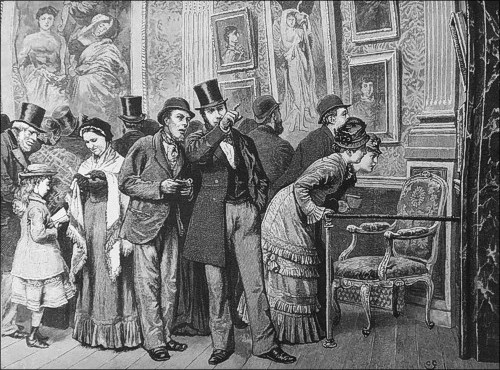|
|
 |
|
| A Sunday Afternoon in a Picture Gallery, The Graphic 1879 |
|
|
|
|
Negli anni Quaranta, in Gran Bretagna, lo scandalo suscitato dalla vendita di opere d’arte antica false stimolò la nascita di un mercato dell’arte contemporanea, che ovviava a problemi di attribuzione e autenticità. Spazi espositivi alternativi a quelli istituzionali, come la Royal Academy o la Society of British Artists, favorivano libere mostre ed elevarono la figura del mercante da semplice gestore di merce, antica o moderna, a intermediario tra artista e collezionista. Negli anni Cinquanta e Sessanta, quindi, furono inaugurate molte gallerie private, con un apice negli anni 1875-85, quando l’invasione di Regent Street e Bond Street associò l’acquisto di dipinti allo shopping di lusso: tipico di questo periodo era lo stravagante arredo della Grosvenor Gallery, inauguratasi nel 1877.
Inoltre, Londra divenne una piazza internazionale, tra l’altro grazie all’attività di molti operatori stranieri, da Gambart a Everard, da Durand-Ruel a Goupil, che avevano sedi anche all’estero. L’introduzione di mostre stagionali e retrospettive incrementò ulteriormente l’utile commerciale delle gallerie: Achille Vertunni espose sei grandi tele alla Dudley Gallery nel 1870, Luigi Premazzi fu celebrato alla Burlington Gallery nel 1879, Nino Costa alla Fine Art Society nel 1882, Telemaco Signorini da Lucas in Hanover Square nel 1883 e Herman Corrodi alla French Gallery nel 1902.
Molti mercanti inglesi avevano iniziato la loro attività come fornitori di articoli per le belle arti, restauratori o corniciai, così come avvenne in Francia e in Italia, e specialmente come commercianti di stampe. Alcuni poi, come Vizard, Coutts Lindsay o Hallé, puntando sul crescente mercato contemporaneo, cercavano approvvigionamenti anche in Italia, facendo acquisti sia alle esposizioni pubbliche, sia rivolgendosi direttamente agli artisti. Appoggiavano questi artisti non solo alla Royal Academy, ma anche presso altre sedi espositive londinesi e in tutta la Gran Bretagna, fornendo la chiave di accesso a una rete capillare dove, già da alcuni decenni, non era facile distinguere il “mercante-agente” dal “gentleman-connoisseur”. Fra i più importanti agenti e mediatori legati agli artisti italiani vanno ricordati: Keningale Cook, Giuseppe Guarducci, Joseph Harris, Joseph Hogarth, Algernon Marsden, Robert McTear, George Squire e Samuel Tolfrey; e fra i diplomatici e aristocratici: Lord Ronald Gower, George Howard, Joseph Severn e lo stesso Frederic Leighton. Inoltre, l’espansione commerciale degli anni Settanta attirò Oltremanica molti italiani, che prediligevano l’appoggio di gallerie alla moda come McLean’s, Tooth’s, la French Gallery, la Grosvenor Gallery o la Fine Art Society.
In Gran Bretagna, si mirava soprattutto al buon esito economico. Tipicamente, in un romanzo del 1892, Bruno Sperani descrive la reazione di un artista italiano premiato da un acquirente inglese: “Mille sterline! esclamò. Quante gli parevano! Una fortuna; un capitale inesauribile”.
|
|
|
In Great Britain, the scandal surrounding the sale of fake Old Master paintings during the 1840s stimulated the creation of a market for contemporary art, which avoided problems of attribution and authenticity. New spaces that provided an alternative to traditional institutions like the Royal Academy or the Society of British Artists encouraged free exhibitions and raised the figure of the dealer from the simple role of trader in antique or modern goods to that of intermediary between artist and collector.
The 1850s and 1860s therefore saw the opening of many private galleries, with a peak in the years from 1875 to 1885, when the increased frequentation of Regent Street and Bond Street associated the purchase of paintings with luxury shopping: the extravagant decor of the Grosvenor Gallery, inaugurated in 1877, typified the period. Moreover, London became an international market place, thanks to the presence of many foreign operators, from Gambart to Durand-Ruel and Goupil, who also had bases abroad.
The introduction of seasonal and retrospective shows further contributed to the commercial profit of the galleries. Achille Vertunni exhibited six large canvases at the Dudley Gallery in 1870. Luigi Premazzi was celebrated at the Burlington Gallery in 1879, Nino Costa at the Fine Art Society in 1882, Telemaco Signorini in Arthur Lucas’s premises in Hanover Square in 1883, Herman Corrodi at the French Gallery in 1902.
Many British dealers began their activity as suppliers of material for the fine arts, restorers or frame-makers, as was often the case in France and Italy, and especially as print-sellers. Some of them, like Vizard, Coutts Lindsay or Hallé, placing their bets on the expanding market for contemporary art, sought supplies in Italy, where they made purchases at the public exhibitions or directly from the artists themselves. They sponsored the artists at the Royal Academy, but also in other exhibition venues in London and elsewhere in Great Britain. They supplied the means for accessing an intricate network in which it had already for some time become difficult to distinguish the dealer or agent from the figure of the gentleman-connoisseur.
Amongst the leading agents and dealers associated with the Italian artists, some were particularly active: Keningale Cook, Joseph Harris, Algernon Marsden, Robert McTear, George Squire and Samuel Tolfrey. Figures of diplomatic importance or aristocratic standing in the same context included: Lord Ronald Gower, George Howard, Joseph Severn, and Frederic Leighton himself. The commercial expansion of the 1870s attracted many Italians across the Channel. In London, they favoured association with fashionable galleries like McLean’s, Tooth’s, the French Gallery, the Grosvenor Gallery or the Fine Art Society.
In Great Britain, Italian artists were chiefly concerned with assuring themselves of economic success. Typically, in a novel of 1892, Bruno Sperani describes the reaction of an Italian artist who had made a sale to an English client: “A thousand pounds!” he exclaimed, “What a sum it seemed to him. A fortune; an inexhaustable supply of money”.
|
|
|
|
|
|